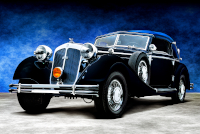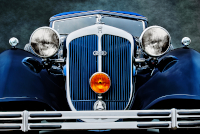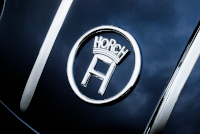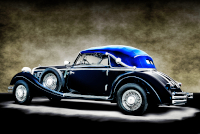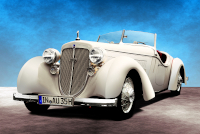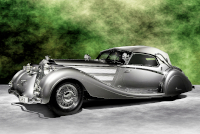Location:
St. Michaels Concours d'Elegance, 2008
Owner: John W. Rich | Pottsville, Pennsylvania
Prologue:
As it happened, we managed to photograph a Horch 853A before ever spotting a classic Mercedes-Benz; this cabriolet here is the first, with source images from a wet afternoon on the Chesapeake Bay. Rather fortuitous, considering the obscurity and rarity of these cars compared to their Stuttgart rivals.
A year later, the same car appeared at Pebble Beach for the Auto Union centennial, parked a spot away from the best of show 853 Sport Cabriolet by Voll & Ruhrbeck. I made do with my original take, and for the old incarnation of this classic car project finished an inconsequential piece.
Now we've revived the Auto Union stock within a diligent effort to give some attention to that slice of complicated history. And in this case, I created two new quarter perspectives. The John Rich classics have not appeared publicly for some time, and so this glimpse from two decades prior feels like history in-and-of itself, and I appreciate the opportunity to profile Horch automobiles much more now than I did back then.
- - - - - - - - - -
► Image Source: Nikon D200 (10.2 MP)
References:
- Automobile Quarterly, Volume 33, Number 2, September 1994, "Horch, The August Motor Car" by Hans-Otto Neubauer, The Kutztown Publishing Company, Inc., Kutztown, PA, page 18-19, 21-22, 28-29
- Automobile Quarterly, Volume 4, Number 2, Fall 1965, "Cars Named After August Horch" by Richard von Frankenburg, The Kutztown Publishing Company, Inc., Kutztown, PA, page 140-142, 145
- UltimateCarPage: Only a brief summary of Horch, with little on the 853 model, but this source is one of few to attempt thorough specifications. Work by Wouter Melissen, (prior to December 2004).
The Horch 853A advances the 853 by means of increased power output; concurrently, these models form the bulk of Auto Union luxury production in the high classic era. Only the überrare 855 expands on the sporting cabriolet concept before the war, and Horch produced a very small number of 853A Special Roadsters besides. These four models are each distinct.
Production of the 853A spans 1936 to 1939, and the production finish remains largely consistent from year to year.
Gläser, the Dresden-based Karosserie, provides coachwork in a style that represents the marque, as well as the broader auto group. In the classic era, Gläser serves a wide clientelle, not all of whom are so elite (vis-à-vis, Opel). So incorporating trademark style into a semi-custom body is a fitting task, and one that provides visual continuity across Audi and Horch models of the 1930s.
The relationship between Gläser and Auto Union is similar to that of LeBaron and Packard, where the coachbuilder standardizes the brand identity on behalf of the manufacturer. Of course Mercedes-Benz establish a similar relationship with their Werk Sindelfingen factory, roughly equivalent to Fleetwood and Cadillac because these relationships are wholly in-house affairs. But for that matter, the Gläser design does not change much from year to year.
This particular Horch 853A is a long-time North American car imported shortly after the war by a US serviceman. Following restoration, the car toured the show circuit in the early otts, winning top honors at a number of concours d'elegance. At Amelia Island in 2004, the Horch outshown a few showstopper classics also found in our catalogue, including the Bugatti Type 57 Grand Raid Roadster, Pierce-Arrow Model 1240A Salon Twelve Silver Arrow, and Duesenberg Model SJ Mormon Meteor Special, (though before J-557 received a full restoration).
I don't normally dwell on concours popularity, but this car gives us pause to consider how classics wax and wane in prominence. As publicity sometimes follows the newness of a restoration, 2008-2009 marks the last we saw of this Horch, which then retreated with the rest of the beautiful J.W. Rich collection. Our glimpse into the past therefore uses a short lens, looking back at the last known public touchpoints.
Motor: 4,944 cc Type T850 straight 8-cylinder, cast-iron block, alloy head | 87 mm x 104 mm | 6.1:1 compression
Valvetrain: SOHC, 2 valves per cylinder
Aspiration: single Solex 35 JFF carburetor
Power: 120 bhp @ 3,600 rpm
Drivetrain: ZF Aphon 4-speed gearbox, rear-wheel drive
Horch models drive the wheels through an Aphon G 30 gearbox developed by ZF in 1929. The box uses spur gears on first and reverse, and helical gears on second, third, and fourth, the primary advantage being quiet operation. The unit uses a staggered layout with overdrive on all forward gears, providing eight speeds total, a wholly modern concept of luxury that helps sustain higher cruising speeds.
Front Suspension: independent, upper A-arms with lower transverse semi-elliptic leaf springs, hydraulic shock absorbers
Rear Suspension: de Dion axle, semi-elliptic leaf springs and hydraulic shock absorbers, Ferdinand Porsche-designed double-jointed axle shafts
Architecture: steel chassis with coachwork by Gläser of Dresden
Kerb Weight: 2,630 kg (5,798 lbs)
Wheelbase: 3,450 mm (135.8 inches)
Top Speed: 135 km/h (83.8 mph)
Etymology:
In numerous accounts, we mention how August Horch, after ouster from his eponymous firm in 1909, established a second company using the Latin derivation of his surname. In German, 'Horch' is the imperative form of the verb, 'to hear,' or 'horchen.' In Latin, the imperative form of the verb 'audire' is of course 'audi.'
For the 853 designation, the '8' refers to the number of cylinders, whereas '5' refers to the near 5-litre capacity. The '3' refers to the model sequence, which began in 1935 with the 850. From the 850 to the 853, Horch uprated the model as the 853A, and ultimately advanced the range with the 855. The A-specification uses an uprated head, producing 15 additional horsepower.
The car is an open cabriolet, the term descended from the carriage trade. Gläser Karosserie of Dresden provides the coachwork, though texts also cite the firm as, "GläserKarosserie," or sometimes use a hyphen. As if to underscore what a cabriolet truly is, Gläser is one of many coachbuilders descended from the carriage trade, founded in the 19th century.
Figures:
Horch completed roughly 400 of the uprated 853A, 404 according to UltimateCarPage.
Value:
The commercial price for a new Horch 853A in 1939 would be $6,250, which translates to $140,000 in today's money.
Grille Forward: Horch Style, American Influence, and the Front-Drive Audi
Compared to Mercedes-Benz, Horch positions the grille far forward, then blends the fender skirts into a flowing valance down beneath the lower curve of the crest. Auto Union kept an eye on foreign trends moreso than their Stuttgart rivals, and through the 1920s drew design influence from LaSalle. On this point, Automobile Quarterly write, "It was claimed that the designs were carried out by noted artists... and it became evident that the artists more or less only lent their names to the designs. But as LaSalle was nearly unknown in Germany (as was Horch in the States), nobody noticed."
The classic era design that followed feels like a continuation of Cadillac-LaSalle influence based on the position of the grille and fenders, with a touch of fluidity similar to the Auburn 851. In comparison, contemporary Mercedes grilles sit far back, with deeply sculpted front wings.
But this design is advantageous for Auto Union in another respect, because Gläser uses the same approach on the Audi UW ("umgekehrter Wanderer") front-drive platform.
In this sense, the grille-forward approach lends elegance and grandeur to the Horch 853, while providing the Audi compartmental space to house a reversed motor and front-mount transaxle.
Thus, Auto Union maintain brand identity among Horch and Audi cars even though the former is a conventional rear-drive platform and the latter is a completely different mechanical specification.
Standard Horch: Common Auto Union Design Elements
The production Gläser cars are perhaps slightly conventional compared to the rare Special Roadsters; they provide visual continuity across the range and kinship with the Audi Front UW cabriolets produced concurrently.
Common design elements include the narrow bonnet louvre arrangement and chrome accents, fender and skirt forms, and even the general proportions where larger Audi cars of the period look like Horch products.
The hood (top) remains one of the prettiest of the classic era, and effects a handsome profile regardless of which coachbuilder assembles the mechanism. In this case, the hood is rounded to match the curve of the rear deck, less the Victoria style seen on the Voll & Rhurbeck Sport Cabriolet.
Wheels also connect 853 cars together across the range, using a large central dish with chrome wire behind. The Horch ring on the rear deck of this 853A matches the wheel caps, which suggests that the Horch emblem is in fact the entire wheel cap, both a symbol and a functional component.
Last Updated: Mar 26, 2025

